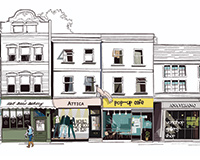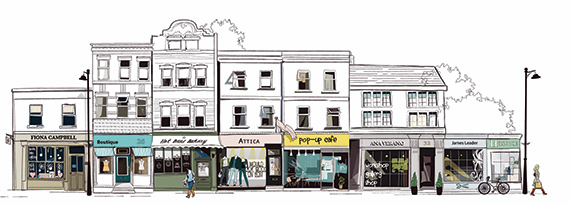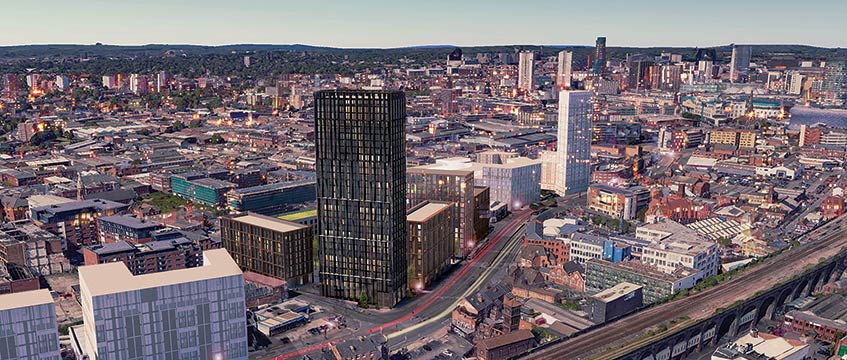London’s housing shortage has prompted landlords to turn over-shop floorspace into modern flats for commuters. And, writes David Thame, the pros of doing so seem to outweigh the cons
It is not recorded what the two floors used to look like above H Samuel The Jeweller, at Powys Street, Woolwich. Probably dull and dusty. Almost certainly not as bad as many upper floors above London suburban shops, the ones with the broken glass and the pigeons flying in and out.
Today the two floors above H Samuel look lovely (see panel, p15). Converted into four apartments, they are expected to appeal to West End commuters and Canary Wharf newcomers. Building work finished in late August, and by now deals are expected to be in solicitors’ hands.
Living above the shop used to be something shopkeepers did. Then, from some time in the 1960s, they generally did not. For the past four decades over-retail residential space has been largely empty, an unwelcome cost to the retailer who finds it added to their bill for rent, rates and often substantial service charge.
Yet in London that is beginning to change. The huge returns to be made from recycling over-shop floorspace into residential is pulling this wasted, forgotten territory back into use. And according to the movement’s pioneers, it means a big win for everyone – except the pigeons.
Gavin Rowlands, director at Nash Bond, is advising Mansford Absolute Return Real Estate on its Woolwich Arsenal Estate. He says the scope for converting what was a predominantly retail portfolio into a residential portfolio is enormous.
“Mansford has 60 retail tenants, mostly on and around Powys Street. They have 62 residential tenants, but we are looking at using over-shop space, which could add another 40-50 residential tenancies. If we used the land associated with the portfolio then we could add many more. There are already residential towers going up in Woolwich, so we could be talking about 400 or more units.”
The H Samuel conversion shows the advantages – and novel fixes – required to make it work.
Rowlands says: “Older high street shops were designed as mixed-use and they don’t have the problems that come with more modern buildings. For instance, there is no problem with finding enough daylight on the upper floors. They sorted this out long ago – smaller floorplates higher up, with windows at the front, windows at the back.”
“However, there is an issue with access to the flats, because high street access can mean loss of street frontage for the shops, which loses prominence for the retailer, and there is a valuation issue for landlords. In the H Samuel case the frontage was wider than average, and the retailer was happy to lose a little to create access to the flats. For the landlord the minimal loss of ground floor retail income is more than made up for by the residential above, at a far higher value.”
It sounds like a winner – but the opportunities for this kind of conversion may be relatively sparse. Because many upper floors are bundled into ground floor retail leases, it is only when a lease comes up for renewal that landlords get a convenient trouble-free opportunity to unbundle the upper floors. And if they are to persuade retailers to co-operate, they need to sell the deal as an advantage for retail tenants, not just a big money spinner for the landlord.
Fortunately, Rowlands says that telling an upbeat story to retailers is not hard. First, losing responsibility for the upper floors probably saves retailers a substantial service charge. Numbers will vary, but a 20% cut in service charge seems plausible. There will also be a cut in business rates – a cut large enough to notice. Even if the retail rent goes up – as it may well, per sq ft – the net effect for the retailer is a substantial fall in occupational costs. Win-win, says Rowlands (see sidepanel).
A second phase of residential conversion in Woolwich is already winning smiles from retailers. When one tenant was asked if it wanted to bid for the building without the upper floors it offered the same rent they were paying on the entire building, suggesting retailers value getting rid of the upper floor liability far more than reducing the rent.
Samantha Blackburn, head of residential property law at Slater & Gordon, warns that although financially appealing, conversion will not always be simple. “Combining residential and commercial usage is not without its challenges, but a good yield can often be produced with the right legal structure in place. We have seen owners granting a fixed-term commercial lease to an intermediary, who then grants an assured short hold tenancy to the residential occupier. The commercial lease ensures that the investment value is safeguarded and removes the burden of management from the owner,” she explains.
“From a legal perspective, there are challenges around these types of properties, particularly in relation to the legislation relating to a tenant’s right of first refusal and around maintenance and repair issues. Also these flats may be cheaper to buy initially, but the resale value may not be as good, particularly if there is a change in the retail use.”
And what about the residents who end up living above shops? Louisa Brodie, formerly of Savills and now search and acquisitions specialist at boutique search agency Banda Property, says that it all depends.
“We recently secured a home for a client above a bookshop in Notting Hill. The client was able to purchase the freehold for the entire building, which meant that they had control over the next tenant, should the bookshop owner move out. This is an ideal position to be in,” she says.
Otherwise, it is about the appeal (or otherwise) of your downstairs neighbours, and contingent problems like getting mortgage finance and reasonably priced household insurance.
“There are obviously several cons for residents to look out for. Some want to be on a quiet street, not a major thoroughfare. Ideally, it would be a street that attracts the kind of boutique shops that are not open 24-seven. The retail unit itself is key. You wouldn’t want to be above a restaurant or bar due to noise and odours,” she says.
“There is the risk that the retail unit may change hands and be taken by a less attractive tenant, such as a noisy bar or takeaway outlet. Other negatives are that it may be more difficult to obtain a favourable mortgage rate as values will fall faster in these types of properties if there is a downturn or price falls in the area, so providers will be cautious. Buildings insurance is also likely to be more expensive if you are above a shop or restaurant owing to the increased risks associated with this, such as flood or fire.
“There are several pros, though – one being security. Being on the first floor or higher is always safer, and if you are above a shop in a smart area, you may be able to capitalise on additional security by the retailer.”
Many observers suggest that, given the complexities, large-scale conversion of upper floors is likely only in areas with high housing pressure, high business rates and sky-high property prices. In other words, only in greater London.
Gavin Rowlands tends to agree. “It probably is just a greater London thing for now,” he says. “The lower the rent and rates, the less incentive retailers have to relinquish upper floor space.”
Living above the shop is no longer something shopkeepers do. But it is something more developers are exploring.
The maths
Creating a street entrance for the four new apartments above H Samuel in Woolwich meant losing about 5% of the ground-floor sales area.
Business rates for H Samuel are sure to look good. On the old figures, losing two upper floors of roughly 1,000 sq ft each would knock £7,000 off a £72,500 rateable value, and about £3,000 pa in rates payable. That is a cut of 10%.
Service charge is more complicated, but losing the upper floors probably lowers the service charge by about 45%, give or take.
Nash Bond’s Gavin Rowlands says: “The pure ‘hassle factor’ of dealing with vacant uppers parts would also be removed, which provides the retailer with certainty rather than inherent risk of squatters, unforeseen/unquantifiable future disrepair, and so on.”
These savings mean a retail unit rent that rose by around 16% caused H Samuel no headaches.












